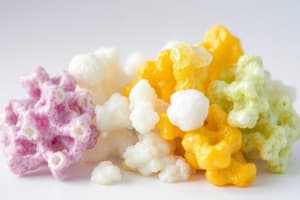Podcast
Questions and Answers
Which property among the following is most sensitive to dislocation structures in materials?
Which property among the following is most sensitive to dislocation structures in materials?
- Transparency
- Yield strength (correct)
- Young’s modulus
- Conductivity
Which term describes materials derived from biological sources that are used in medical applications?
Which term describes materials derived from biological sources that are used in medical applications?
- Wound
- Biological material (correct)
- Normal tissue
- Infected wound
What type of tissue can be characterized as having no active infection, promoting healing?
What type of tissue can be characterized as having no active infection, promoting healing?
- Infected wound
- Wound
- Biomaterial
- Normal tissue (correct)
Which of the following correctly matches with its definition in a biomedical context?
Which of the following correctly matches with its definition in a biomedical context?
Which of the following terms refers to the clinical state characterized by the presence of pathogens in the tissue?
Which of the following terms refers to the clinical state characterized by the presence of pathogens in the tissue?
Flashcards are hidden until you start studying
Study Notes
Material Properties & Dislocations
- Yield strength is most sensitive to dislocation structures in materials.
- Dislocations are line defects in the crystal lattice that allow for plastic deformation under stress.
- The presence of dislocations reduces the stress required for plastic deformation, lowering the yield strength.
- Young's modulus, transparency, and conductivity are less sensitive to dislocation structures.
Biomaterials
- Biomaterials are materials designed to interact with biological systems.
- They can be natural or synthetic.
- Examples include polymers, ceramics, metals, and composites.
- Important aspects include:
- Biocompatibility: The material's ability to coexist with biological systems without causing adverse reactions.
- Bioactivity: The material's ability to elicit a specific biological response.
Biomedical Material
- Biomedical material is a broader category that encompasses materials used in medical devices and procedures.
- It includes biomaterials and other materials that are not necessarily designed for direct interaction with the body.
Biological Material
- Biological material refers to materials found in living organisms.
- Examples include bone, cartilage, and skin.
- They have unique structures and properties that make them suitable for their biological functions.
Normal Tissue
- Normal tissue refers to healthy tissues that are functioning properly.
- They have specific structures and functions that are vital for the body to thrive.
Wound
- A wound is an injury that damages tissue.
- Wounds can range in severity from minor cuts and abrasions to severe injuries involving major tissue damage.
- Wounds are often classified based on the nature of the injury, the depth, and the presence of foreign bodies.
Infected Wound
- An infected wound is a wound that has been contaminated with microorganisms.
- This contamination can lead to inflammation, pain, and potential complications.
- Different types of infections require different approaches to treatment.
Studying That Suits You
Use AI to generate personalized quizzes and flashcards to suit your learning preferences.




